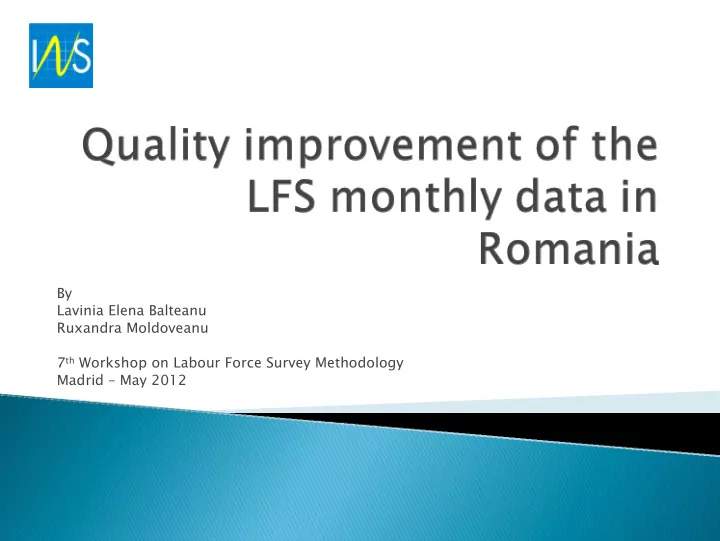

By Lavinia Elena Balteanu Ruxandra Moldoveanu 7 th Workshop on Labour Force Survey Methodology Madrid – May 2012
� Background � Sampling plan � Filed-work � Methodological approaches � Dissemination � Conclusions
Why to do it? � High interest expressed by the users and employment policy makers � The estimated monthly time series allow the assessment of short term unemployment trend.
� A two-stage sampling technique ◦ 1st stage: a stratified random sample of 780 areas, Primary Sampling Units (PSU) was design after the 2002 census, using a stratification criteria the residence area and county . ◦ 2nd stage: 9360 clusters, composed of 3 housing unit each - systematically selected from the initial sample of PSUs. ◦ The final sample consists of 28080 dwelling units.
� sample built based on the dwellings rotation proceeding (rotational scheme 2-2-2): a dwelling is surveyed for two successive quarters, it is temporarily taken out from the survey in the next two quarters, it is introduced again in the survey in the next two quarters, then it is taken out for good from the survey → a dwelling is administrated for 6 quarters.
� PAPI interviews � At territorial area level At territorial area level: data entry from questionnaires, checking rules and correcting errors, data validation, monthly databases sent from regional offices to the central level for final processing at M+28 � At INS – At INS – headquarter level headquarter level: sampling, monthly data processing, data validation, data weighting, data tabulation, data dissemination
For monthly unemployment estimates � Receiving monthly micro ‐ data � Data validation � Monthly weighting and data analysis � Applying the algorithm for monthly estimates � Seasonal adjustment � Quality assessment of monthly data � Data dissemination
� First attempt to produce monthly estimates First attempt to produce monthly estimates from the quarterly survey was done in 2006- 2007 within PHARE Stat 2004 project - with financial support from Eurostat. Data series considered: 2002-2006 � At that time...
...two possible approaches were tested: � genuine monthly estimates: ◦ weighting of the monthly sample using a procedure similar to that one used for the quarterly results but with reduced calibration scheme: NUTS 2 (8 regions) x residence area (urban/rural) x gender x age � 3 monthly moving averages: creation of moving "quarters" which were weighted similar to regular quarter: NUTS 2 (8 regions) x residence area (urban/rural) x gender x 5 years age groups.
Two problems to be solved: � Timeliness – due to PAPI data collection, data are not available in due time in order to perform estimates � Reduce volatility
� New attempt... New attempt... Algorithm - a first improvement with no additional costs was done in 2008 → reallocation of the sample (within the strata) on the reference weeks so that the monthly samples become more balanced at NUTS 2 level.
� For the estimated time series on ILO monthly unemployment, the data weighting procedure is similar with that used for quarterly LFS data; the only differences: ◦ procedures applied for a sub-sample (monthly instead of quarterly): the initial sample is divided into 3 sub-samples corresponding to the 3 months of the quarter � monthly samples weighted applying a reduced calibration schemes → initial monthly estimates
� Based on the initial estimation, a variant of Holt method is applied; this exponentially smooth data series that show a linear trend → monthly time series of projected estimates � In order to obtain an idea about the results of the applied method, the estimates are compared to a benchmarked data series → monthly forecast time series (not seasonally adjusted) � Adjustments are performed by using DEMETRA – TRAMO/SEATS.
� Quarterly, after finalizing quarterly result from LFS, by benchmarking (e.g.: in May the estimates for January, February and March are revised and April is released as forecasted value). � Annually, re ‐ estimation of the model used for seasonal adjustment → the revision the entire series (seasonally adjusted and trend) are revised.
� Analyzing of the estimates from one month to the other and from a quarter to the other as well as comparing with the same period of the previous year � Analyzing of the monthly estimates by comparing with the quarterly results � Analyzing of the LFS micro ‐ data for ensuring the data accuracy and availability at the requested deadline � Ensuring the comparability with definitions and concepts used at EU level.
� Main indicators obtained: ◦ ILO unemployed – total (15 ‐ 74 years) by gender and age groups (15 ‐ 24 years and 25 ‐ 74 years) – NSA, SA, T ◦ ILO unemployment rate – total (15 ‐ 74 years) by gender and age groups (15 ‐ 24 years and 25 ‐ 74 years) ‐ NSA, SA, T � Sending to Eurostat at M+25 days � Press release – monthly at M+30 days � TEMPO on ‐ line database � Monthly Statistical Bulletin
NSA SA Unemployment – Unemployment rate Unemployment – Unemployment thou pers % thou pers rate ‐ % First Revised First Revised First Revised First Revised release release release release 2011 June 697207 681059 7.1 6.9 2011 June 727276 725073 7.5 7.4 July 690794 717590 7.0 7.2 July 707101 731736 7.3 7.5 August 679734 713606 6.9 7.2 August 708864 728770 7.3 7.5 September 684317 723664 6.9 7.3 September 727308 748014 7.5 7.7 October 708214 718886 7.2 7.4 October 726944 721906 7.3 7.3 November 712947 770405 7.2 7.9 November 726863 750215 7.3 7.6 December 697442 763964 7.1 7.8 December 703224 751422 7.0 7.5
Even not so accurate than the quarterly data, the monthly estimates provide more rapid information that is requested by the users... More information on: http://www.insse.ro/cms/rw/pages/comunicat e/somaj%20BIM.en.do E-mail: ruxandra.moldoveanu@insse.ro lavinia.balteanu@insse.ro
Recommend
More recommend